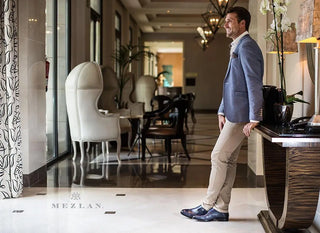The history or Mezlan Shoes
This would become a critical factor in Almansa’s reputation as the highest quality shoemaking factories in all of Spain. Almansa, Spain is the birthplace and home to Mezlan. Located in the arid but fertile plains between the high central plateau of La Mancha and the Mediterranean Sea, the town of Almansa is set at the foot of a majestic, rising white limestone cliff. Surmounted by a breathtaking 14th century Moorish castle, the Castle of Almansa, the town lays claim to being Spain’s shoe making capital.
Almansa has the oldest reservoir in Europe, built in 1584. For the town and for the resident artisan craftsmen of Mezlan, this reservoir serves as a source of flowing inspiration and creativity.
Though the Mezlan factory took root in the mid-20th century, its ancestral roots go far back into the time-honored traditions of the artisan craftsmen of the region who embody this treasured culture. Exquisite leather products, tanned and crafted in Spain, have been praised, valued and enjoyed for centuries by the patrons of Europe’s great cities.Up until the mid-19th century, this region of Spain was home to small artisan communities of country laborers. Using the revered master-apprentice relationship for shoemaking, they cultivated the skills and the art of the craft. Many of the shoes at that time were produced for local aristocracy who possessed the highest levels of wealth but by the mid-19th century, artisan production started to evolve from small homework shops to the very first factories. This development of the shoemaking trade came to life as a result of three strategic factors. Firstly, Almansa had a privileged geographical location which linked it to the vital cities of Madrid, Valencia and Alicante. The value of its location was reaffirmed in 1858 with the inauguration of the Madrid-Alicante railway that passed through Albacete and Almansa. Secondly, there was the existence of a large and talented artisanal contingent of highly skilled shoemakers in the area.
And lastly, with gradual improvements in transportation, including the role of the muleteers, the industry got a much-needed boost in commercialization by allowing local artisans to sell their shoes to consumers of distant towns outside the immediate Almansa area. This fueled growth and an accumulation of capital, allowing for the first factories to be built in the area.
Almansa also had the good fortune of being home to several strong, local families of master shoemakers who helped the town transition from one of simple shoemakers to pioneers of industry. They incorporated progressive mechanization processes which used the newest shoemaking machinery of the time. By the turn of the century, a strong and enterprising production in shoe making was taking place. This continued for many years, making Almansa the highest capacity shoe-producing town in all of Spain.
The shoe markets opened internationally during and after the First World War and continued to expand and flourish right up until the start of the Spanish Civil War in 1936. These hard times saw a dramatic decline in the local shoemaking industry, continuing for many years through the earlier half of the Franco era. Then, during the 1960’s the shoemaking industry in Almansa began to redevelop at a more rapid pace. A great number of small factories were being staffed, once again, by the traditional artisan shoemakers, many of whom were returning back to the area.
Throughout the economic ups and downs of the last half century, the strength of Almansa’s footwear production, and that of the Mezlan factory in particular, continues to be the production of high-quality men’s shoes worn by very discerning gentlemen who enjoy a heightened sense of fashion in their lives.


